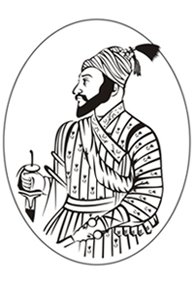Mirza Raja Jai Singh of Amber was the most powerful and influential Hindu noble in the Mughal service at that time. After every Imperial commander had failed to check Shivaji's rapidly growing power, he was sent by Aurangzeb to deal with the Maratha hero. Mirza Raja, certainly the ablest military commander and diplomat of his time, conducted the campaign against Shivaji with great success. On 3rd March 1665 he had reached Pune and a few days later commenced the siege of Purandar fort. After a few months Shivaji thought it prudent to conclude peace, at least for the time being.
On 11th June 1665, Mirza Raja Jai Singh received Shivaji at the foot of the Purandar fort, then being besieged by him, its fall being imminent. Shivaji arrived in a palquin accompanied by six Brahmans. Jai Singh received Shivaji in the tent, embraced him and seated him by his side, "while Rajputs stood around to guard against any treacherous movement on the part of the slayer of Afzal Khan". From the tent, the fighting on the slopes of the fort could be seen. Shivaji now agreed to conclude the famous treaty of Purandar (12-13 June 1665).
The meeting cemented the ties between the Kachwaha house of Amber (Jaipur) and Shivaji. Later, on so many occasions, these ties were cited by the Jaipur rulers, Chhatrapatis and Peshwas in their correspondence. It was only Mirza Raja's oath assuring safe conduct for Shivaji that Aurangzeb did not dare to put him to death at Agra in 1666.
The historic meeting between the two renowned men of that time had great significance and paved the way for Shivaji's visit to Agra (May 1666), a visit which despite a few months of great anxiety and threat to Shivaji's life, ultimately ended on a happy note.
Details of the next painting
There is a spacious enclosure of the kanats. In the center of the enclosure is an open tent from which furious fight on the slopes of the Purandar fort can be seen. Armed Rajput warriors have formed a ring outside the kanat enclosure. Shivaji is accompanied by 2 Brahmins. His palquin is placed inside the enclosure at some distance. Mirza Raja is shown welcoming Shivaji. Mriza Raja is accompanied by his son Kirat Singh, Manucci (an Italian, then in Mirza Raja's service as chief gunner, and the author of Storia Do Mogor). Shivaji's high spirit is evident from his personality.
On 11th June 1665, Mirza Raja Jai Singh received Shivaji at the foot of the Purandar fort, then being besieged by him, its fall being imminent. Shivaji arrived in a palquin accompanied by six Brahmans. Jai Singh received Shivaji in the tent, embraced him and seated him by his side, "while Rajputs stood around to guard against any treacherous movement on the part of the slayer of Afzal Khan". From the tent, the fighting on the slopes of the fort could be seen. Shivaji now agreed to conclude the famous treaty of Purandar (12-13 June 1665).
The meeting cemented the ties between the Kachwaha house of Amber (Jaipur) and Shivaji. Later, on so many occasions, these ties were cited by the Jaipur rulers, Chhatrapatis and Peshwas in their correspondence. It was only Mirza Raja's oath assuring safe conduct for Shivaji that Aurangzeb did not dare to put him to death at Agra in 1666.
The historic meeting between the two renowned men of that time had great significance and paved the way for Shivaji's visit to Agra (May 1666), a visit which despite a few months of great anxiety and threat to Shivaji's life, ultimately ended on a happy note.
Details of the next painting
There is a spacious enclosure of the kanats. In the center of the enclosure is an open tent from which furious fight on the slopes of the Purandar fort can be seen. Armed Rajput warriors have formed a ring outside the kanat enclosure. Shivaji is accompanied by 2 Brahmins. His palquin is placed inside the enclosure at some distance. Mirza Raja is shown welcoming Shivaji. Mriza Raja is accompanied by his son Kirat Singh, Manucci (an Italian, then in Mirza Raja's service as chief gunner, and the author of Storia Do Mogor). Shivaji's high spirit is evident from his personality.

